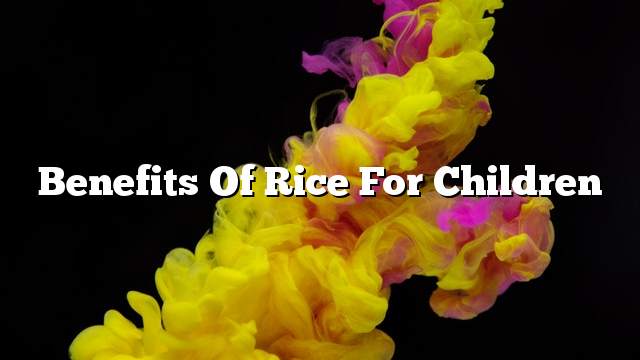Child Nutrition
Children are the age group between the postpartum and puberty stages. They should receive special care and attention from parents and especially, they are in the stage of physical and mental development. They need healthy and healthy nutrition, and the body needs basic nutrients, thus helping the child’s body grow. And advised mothers to diversify the forms of healthy foods provided to the child to provide him with nutrients important for the development of his body in a healthy way.
This article presents one of the most important ingredients to be provided to children to help build strong bodies: rice. What are the benefits of rice for children? How does it help to strengthen the body and protect it from diseases?
Rice
Rice is one of the oldest cereal crops, and has been found for more than 5,000 years. It is a staple food for more than half of the world’s population, especially those living in South and East Asia such as India, China, Sri Lanka, Indonesia, Bangladesh and the Philippines, Malaysia, Thailand, Vietnam, North Korea, South Korea and Japan. Its native home was in East Asia in the Chinese Yangtze Valley, and then spread to India and then to the rest of the world.
Rice has two types: white rice, the most common and used, and brown rice, which is popular in Western countries because of its health benefits. Brown rice may be brown, purple and black.
The nutritional value of rice
Carbohydrates account for 90% of dry rice and 87% of calories gained from rice, which is an important source of energy. White rice contains less fiber than brown rice. Vitamins and minerals contain manganese, selenium, vitamin B1 and vitamin B3, as well as amino acids that help build muscle.
The difference between white rice and brown rice
Unlike white rice, which is refined and stripped from the bran and seed embryo to improve its taste and characteristics during cooking and increase its shelf life, brown rice is made of whole grains with bran and embryo. This has higher fiber content and is healthier than white rice, and bran seeds contain a good proportion of vitamins, minerals and antioxidants lost by white rice because of the removal of crusts. Due to these differences, brown rice is the best in terms of health and nutrition, and advised patients exposed to diabetes or those who eat it, because it contains a high percentage of fiber that reduce the body’s absorption of carbohydrates and rice, thus reducing the proportion of sugar in blood. They recommend avoiding white rice, which leads to high blood sugar.
The benefit of rice for children
Rice is of great benefit to children. It is also one of the foods that are less likely to cause allergies to children. The baby may start eating it at the age of five months or more.
- It is a treatment for diarrhea problems in children, and other digestive problems, and also reduces the problems of gastroenteritis.
- Reduces the production of stool in children, by drinking rice water, boiling rice and water on the fire for about quarter of an hour, and drink the child of this boiled nearly every four hours.
- It helps to provide the body of the child with energy and vitality and increase its activity, because of the high content of carbohydrates, and prefer to boil rice and mixed with milk and given to the child as a meal provided energy throughout the day.
- Rice is a good food meal for children with low cholesterol and fat.
- Rice contains many important nutrients for the child’s physical and mental development, such as vitamin B complex, vitamin D, iron, calcium and others.
General advice when using rice as food for children
When using rice as food for the child, the mother recommends taking into consideration some things, including:
- Choose the good quality of rice for your child, where rice is found in several forms and types, including long grain, medium and short length, and long grain is the most expensive price while rice grain medium long and short less expensive, and despite the difference in prices but they are very similar in their characteristics and benefits. Thus the mother can use medium and short grain for the child.
- When preparing the rice, it should be washed with water. It is also best to be soaked for about an hour to make it easy to cook.
- When preparing rice for infants, it is recommended that it be boiled for a longer period until it is closer to the dough.
- Be careful to feed the child rice meals in moderate amounts and commensurate with the needs of his body, excessive eating rice may be a cause of obesity in children as a result of the contain carbohydrates.
- Although rice is considered to be one of the least allergens in children, the chance remains for the child to become allergic to the rice. If symptoms such as rash, vomiting, or swelling of the mouth and tongue are present in the child after eating the rice, emergency if necessary.
Preparation of mashed rice for children
Preparation of this dish is easy and does not take much time. To prepare this dish, use two tablespoons of white washed and drained rice after soaking for a period of time and half a cup of formula or mother’s milk. Of water, then put the rice in a saucepan over low heat and cover with water until it is well boiled or softened, and after boiling it is placed in the blender and added to milk or breast milk, and then introduced to the child.
